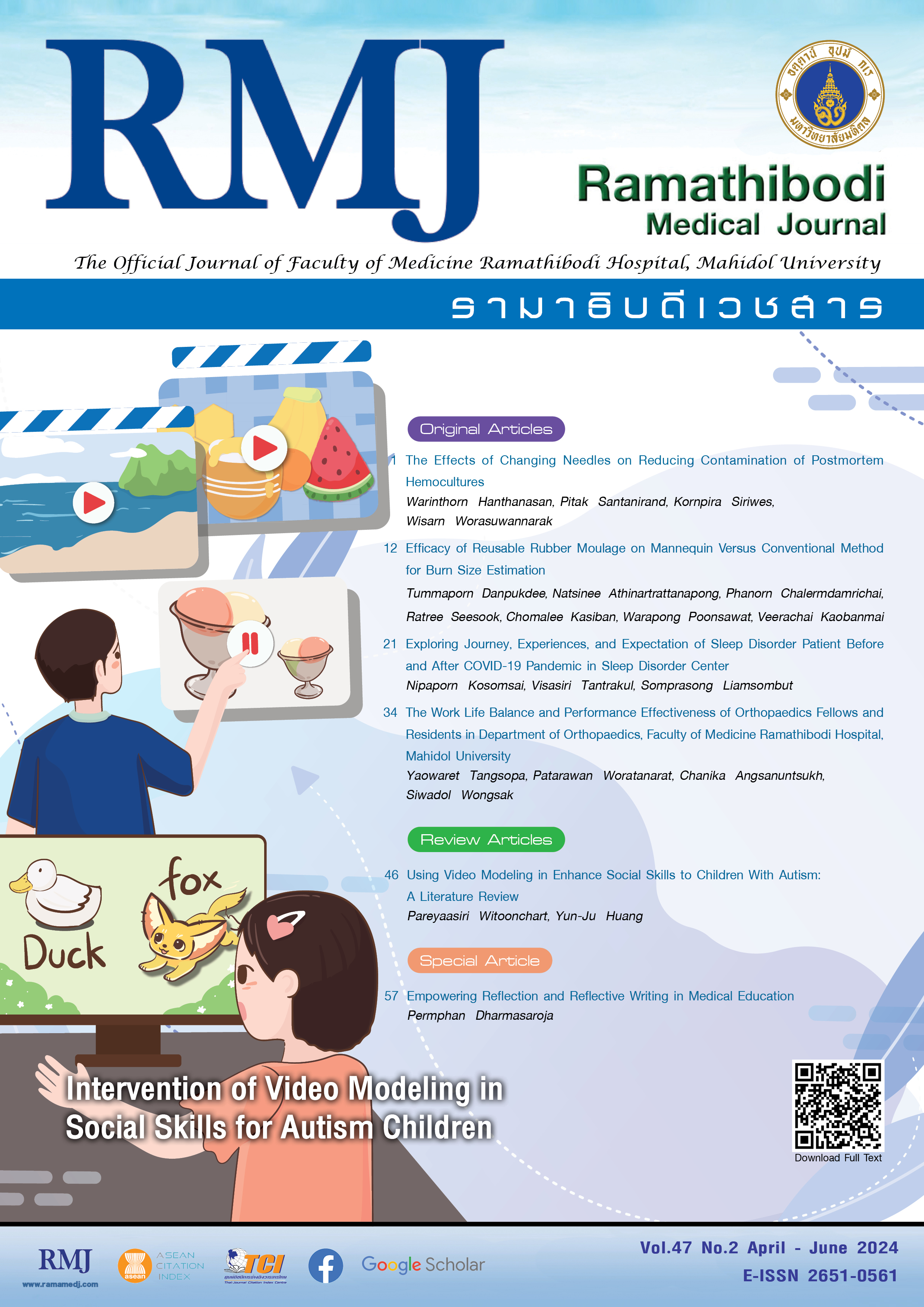Using Video Modeling in Enhance Social Skills to Children With Autism: A Literature Review
DOI:
https://doi.org/10.33165/rmj.2024.47.2.266424Keywords:
Video modeling, Autism, Social skillsAbstract
The objective of this research paper is to explore the advantages, limitations, and empirical evidence for the effectiveness of video modeling as an instructional approach for children with autism. Video modeling, which falls under assistive technology in therapeutic intervention strategies, utilizes videos to exhibit desired behaviors and competencies. A total of 28 research articles, carefully selected from 3 reputable publication resources (APA PsycNet, Springer, and Eric), were analyzed through content analysis. These articles were published in online databases between 2000 and 2024. The following sections of the paper delve into the benefits of video modeling, including improved learning opportunities, increased engagement, and transferable skills. Furthermore, the paper presents empirical research findings that support the positive impact of video modeling on enhancing social skills in children with autism.
References
Wong C, Odom SL, Hume KA, et al. Evidence-based practices for children, youth, and young adults with autism spectrum disorder: a comprehensive review. J Autism Dev Disord. 2015;45(7):1951-1966. doi:10.1007/s10803-014-2351-z
Sherer MR, Schreibman L. Individual behavioral profiles and predictors of treatment effectiveness for children with autism. J Consult Clin Psychol. 2005;73(3):525-538. doi:10.1037/0022-006X.73.3.525
Bugged T. Video self-modeling applications with students with autism spectrum disorder in a small private school setting. Focus Autism Other Dev Disabl. 2005;20(1):52-63. doi:10.1177/10883576050200010501
Charlop-Christy MH, Le L, Freeman KA. A comparison of video modeling with in vivo modeling for teaching children with autism. J Autism Dev Disord. 2000;30(6):537-552. doi:10.1023/a:1005635326276
Nikopoulos CK, Keenan M. Effects of video modeling on social initiations by children with autism. J Appl Behav Anal. 2004;37(1):93-96. doi:10.1901/jaba.2004.37-93
Brook SL. Video modeling. In: Brook SL, ed. The Use of the Creative Therapies with Autism Spectrum Disorders. Charles C Thomas Pub Ltd; 2009:3-17.
Corbett BA, Abdullah M. Video modelling: why does it work for children with autism? J Early Intensive Behav Interv. 2005;2(1):2-8. doi:10.1037/h0100294
Bellini S, Akullian J. A meta-analysis of video modeling and video self-modeling interventions for children and adolescents with autism spectrum disorders. Exceptional Children. 2007;73(3):264-287. doi:10.1177/001440290707300301
Wang SY, Cui Y, Parrila R. Examining the effectiveness of peer-mediated and video-modeling social skills interventions for children with autism spectrum disorders: a meta-analysis in single-case research using HLM. Res Autism Spectr Disord. 2011;5(1):562-569. doi:10.1016/j.rasd.2010.06.023
Charlop-Christy MH, Daneshvar S. Using video modeling to teach perspective taking to children with autism. J Posit Behav Interv. 2003;5(1):12-21. doi:10.1177/10983007030050010101
Scattone D. Social skills interventions for children with autism. Psychol Schs. 2007;44(7): 717-726. doi:10.1002/pits.20260
Nikopoulos CK, Keenan M. Promoting social initiation children with autism using video modeling. Behav Intervent. 2003;18(2):87-108. doi:10.1002/bin.129
Corbett BA. Video modeling: a window into the world of autism. Behav Anal Today. 2003;4(3):367-377. doi:10.1037/h0100025
Wahoski J. Video modeling: an intervention for autism. BU Journal of Graduate Studies in Education. 2015;7(1):54-59.
Nikopoulos CK, Kennan M. Using video modeling to teach complex social sequences to children with autism. J Autism Dev Disord. 2007;37(4):678-693. doi:10.1007/s10803-006-0195-x
Darden-Brunson F, Green A, Goldstein H. Video-Based Instruction for Children with Autism. In: Luiselli JK, Russo DC, Christian WP, Wilczynski SM, eds. Effective Practices for Children with Autism: Educational and Behavioral Support Interventions that Work. Oxford University Press; 2008:241-268.
Frolli A, Ricci MC, Bosco A, et al. Video modeling and social skills learning in ASD-HF. Children (Basel). 2020;7(12):279. doi:10.3390/children7120279
Wynkoop KS, Robertson RE, Schwartz R. The effects of two video modeling interventions on the independent living skills of students with autism spectrum disorder and intellectual disability. J Spec Educ Technol. 2018;33(3):145-158. doi:10.1177/0162643417746149
Cihak DF, Smith CC, Cornett A, Coleman MB. The use of video modeling with the picture exchange communication system to increase independent communicative initiations in preschoolers with autism and developmental delays. Focus Autism Other Dev Disabl. 2012;27(1):3-11. doi:10.1177/1088357611428426
Tetreault A, Lerman D. Teaching social skills to children with autism using point-of-view video modeling. Educ Treat Child. 2010;33(3):395-419. doi:10.1353/etc.0.0105
Ogilvie CR. Step by step: social skills instruction for students with autism spectrum disorder using video models and peer mentors. Teach Except Child. 2011;43(6):20-26. doi:10.1177/004005991104300602
Hong ER, Ganz JB, Mason R, et al. The effects of video modeling in teaching functional living skills to persons with ASD: a meta-analysis of single-case studies. Res Dev Disabil. 2016;57:158-169. doi:10.1016/j.ridd.2016.07.001
Clare SK, Jenson WR, Kehle TJ, Bray MA. Self-modeling as a treatment for increasing on-task behavior. Psychol Schs. 2000;37(6):517-522. doi:10.1002/1520-6807(200011)37:6<517::AID-PITS4>3.0.CO;2-Y
Cihak DF. Using video modeling via handheld computers to improve geometry skills for high school students with learning disabilities. J Spec Educ Technol. 2009;24(4):17-29. doi:10.1177/016264340902400402
Prater MA, Carter NJ, Hitchcock C, Dowrick P. Video self-modeling to improve academic performance: a literature review. Psychol Schs. 2012;49(1):71-78. doi:10.1002/pits.20617
Smith M, Ayres K, Mechling L, Smith K. Comparison of the effects of video modelling with narration vs video modelling on the functional skill acquisition of adolescents with autism. Educ Train Autism Dev Disabil. 2013;48(2):164-178.
Cannella-Malone H, Sigafoos J, O’Reilly M, de la Cruz B, Edrisinha C, Lancioni GE. Comparing video prompting to video modeling for teaching daily living skills to six adults with developmental disabilities. Educ Train Autism Dev Disabil. 2006;41(4):344-356.
Hart JE, Whalon KJ. Using video self-modeling via iPads to increase academic responding of an adolescent with autism spectrum disorder and intellectual disability. Educ Train Autism Dev Disabil. 2012;47(4):438-456.
Downloads
Published
How to Cite
Issue
Section
License
Copyright (c) 2024 Ramathibodi Medical Journal

This work is licensed under a Creative Commons Attribution-NonCommercial-NoDerivatives 4.0 International License.

















